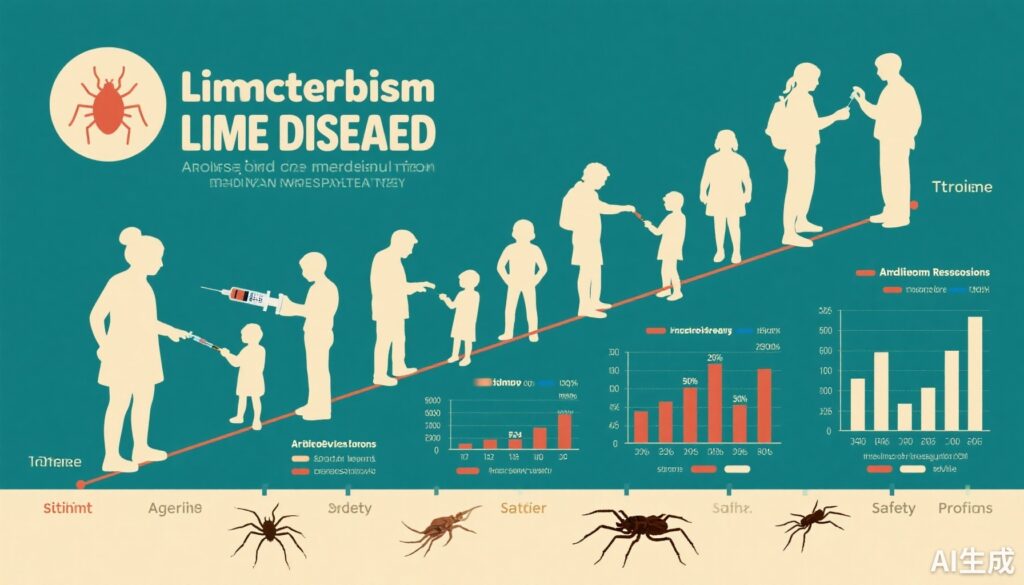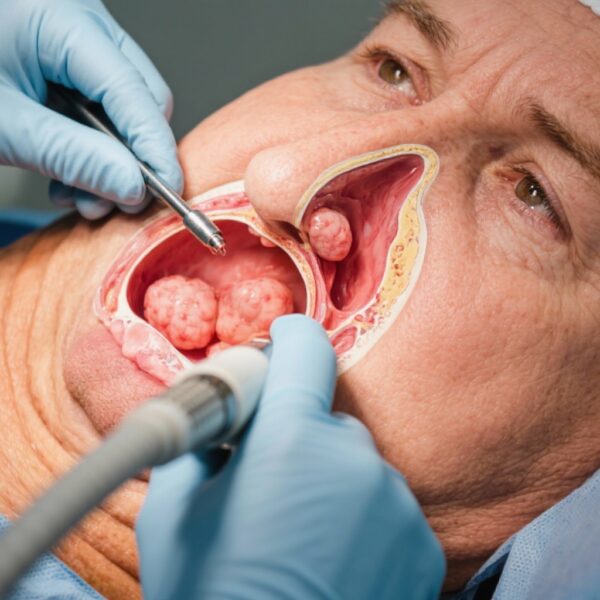Highlights
- VLA15, a multivalent outer surface protein A (OspA) vaccine targeting Borrelia burgdorferi serotypes, shows robust immunogenicity across adults, adolescents, and children.
- Two-dose and three-dose vaccination schedules are both immunogenic, with the 0-2-6 month three-dose schedule eliciting higher antibody titers.
- Children and adolescents demonstrate higher IgG geometric mean titers than adults, suggesting potential for greater vaccine efficacy or dosing flexibility in younger populations.
- Safety profiles are favorable across age groups, with mild to moderate local and systemic reactions and no vaccine-related serious adverse events.
Background
Lyme borreliosis remains the most common tick-borne disease in North America and Europe, with rising incidence and limitations in preventive strategies such as exposure avoidance and timely antibiotic treatments. Potential for serious late sequelae underscores the need for safe and effective vaccines. VLA15 is an investigational vaccine targeting six clinically relevant OspA serotypes from Borrelia burgdorferi sensu lato strains prevalent in North America and Europe. Previous adult studies demonstrated safety and immunogenicity with three-dose regimens; however, data in broader populations, especially children and adolescents—who are at increased risk—were lacking. This review focuses on the key Phase 2 trial elucidating immunogenicity and safety across 5–65 years age groups using different dosing schedules, along with integration of prior studies that optimized dosing and vaccination strategies.
Key Content
1. Chronological Development of Evidence on VLA15
- Phase 1 trials (2017–2019): Wagner et al. (2023) demonstrated initial safety and immunogenicity of VLA15 in adults aged 18–40 years across escalating doses (12, 48, 90 μg) with alum adjuvant, confirming immune responses against all six OspA serotypes. Adverse events were mostly mild or moderate, including injection site tenderness and systemic symptoms like headache and fatigue.
- Phase 2 dose and schedule optimization studies (2019–2024): Two randomized, observer-blind, placebo-controlled studies (Wagner et al. 2024) in adults aged 18–65 years evaluated 90, 135, and 180 μg doses on varying schedules (0-1-2 months vs. 0-2-6 months). The 180 μg dose administered at months 0, 2, and 6 yielded the highest geometric mean antibody titers (GMTs) and was well tolerated, supporting this as the optimal dosing schedule.
- Phase 2 trial including children and adolescents (2021–2025): The pivotal study by Wagner et al. (2025) extended evaluation to individuals aged 5–65 years across three age cohorts (5–11, 12–17, 18–65), comparing a three-dose schedule (months 0, 2, 6) and a two-dose schedule (months 0 and 6 with placebo at month 2) to placebo. This trial demonstrated significant immunogenicity with both schedules, higher in the 3-dose regimen, and highest in children, followed by adolescents, then adults. Safety findings showed solicited local and systemic adverse events were more frequent in vaccine groups but were predominantly mild to moderate with no vaccine-related serious adverse events.
- Booster dose study (2024): A booster trial (2024) in adults showed a single booster dose at 18 months after primary vaccination induced strong anamnestic responses across all six OspA serotypes, with favorable safety and tolerability, though antibody titers waned by month 30, indicating possible need for annual boosters.
2. Immunogenicity Findings Across Age Groups and Schedules
The primary immunogenicity endpoint of the 2025 Phase 2 trial was OspA serotype-specific IgG geometric mean titers (GMTs) measured by ELISA one month after the third vaccination (month 7). Key findings:
| Schedule | Age Group | GMT Range Across OspA Serotypes (Units/mL) | Comparison |
|---|---|---|---|
| Three-dose (M0-2-6) | Children (5–11) | Highest GMTs overall (e.g., ST2 ~656 U/mL) | Significantly higher than 2-dose and placebo (p<0.0001) |
| Three-dose (M0-2-6) | Adolescents (12–17) | Intermediate GMTs | Significantly higher than adults and placebo |
| Three-dose (M0-2-6) | Adults (18–65) | Lower than children and adolescents | Higher than placebo |
| Two-dose (M0-6) | All ages (5–65) | GMTs significantly elevated vs. placebo but lower than 3-dose group | p<0.0001 vs placebo |
| Placebo | All ages | Low baseline GMTs | Reference |
These data indicate the three-dose regimen at 0, 2, and 6 months induces superior immune responses, yet even the two-dose schedule offers significantly enhanced antibody levels over placebo. The augmented immunogenicity in younger age groups, higher than previously reported adult cohorts, suggests immunosenescence or prior exposure differences as factors.
3. Safety and Reactogenicity Profile
Solicited local adverse events (mainly injection site pain, tenderness) were reported in ~94% of vaccine recipients versus ~34% placebo recipients, consistent across both vaccine dosing groups. Systemic adverse events (fatigue, headache) also occurred more frequently in vaccine groups (approximately two-thirds) compared to placebo (~51%) but were mostly Grade 1 or 2. There were no Grade 4 adverse events reported.
Importantly, unsolicited adverse events, serious adverse events, and adverse events of special interest were balanced across vaccine and placebo groups, with none deemed vaccine-related. No deaths occurred through 12 months. Previous smaller studies confirmed similar tolerability profiles with no evidence of cumulative toxicity.
4. Insights from Earlier OspA Vaccine Development
Prior to VLA15, licensed vaccines targeting OspA, such as LYMErix, documented efficacy in adults and adolescents with good safety profiles but were withdrawn from the market largely due to limited uptake and concerns over autoimmune phenomena. VLA15 incorporates multiple OspA serotypes to broaden seroprotection. Earlier trials established dose–response relationships and identified aluminum adjuvant use to enhance immunogenicity, aligning with observations in recent VLA15 trials.
Expert Commentary
The phase 2 trial confirms the safety and immunogenicity of VLA15 across a wide age spectrum, a crucial advance given the increased Lyme borreliosis risk and disease burden in pediatric populations. The higher immunogenicity observed in children and adolescents warrants consideration of potential for dose-sparing strategies or reduced booster frequency in these groups, which could improve vaccine acceptance and compliance.
Mechanistically, the inclusion of six OspA serotypes addresses the geographical variability in Borrelia strains, potentially enhancing vaccine coverage beyond previous OspA vaccines. The sustained antibody titers post-booster administration in adults indicate development of immunologic memory, essential for long-term protection despite waning titers.
Regulatory perspectives will likely favor the three-dose 0-2-6 month schedule with 180 μg VLA15 dose based on optimal immunogenicity and acceptable safety profiles. Nonetheless, the two-dose schedule’s significant immune responses suggest flexibility in real-world immunization programs, balancing compliance and resource considerations.
Clinical application awaits Phase 3 efficacy trials; however, these data fill a critical gap particularly for pediatric Lyme disease prevention. Further post-marketing surveillance will be essential to monitor rare adverse events and long-term efficacy.
Conclusion
VLA15 represents a promising Lyme borreliosis vaccine candidate demonstrating favorable safety and robust immunogenicity in adults, adolescents, and children aged five years and older. Three-dose regimens at months 0, 2, and 6 optimally elicit high antibody titers against six relevant OspA serotypes, with children displaying the strongest responses. Safety profiles are consistent with mild to moderate reactogenicity and no serious vaccine-related adverse events. These findings advance the clinical development pathway for VLA15, positioning it as a critical tool to address Lyme borreliosis prevention unmet needs across vulnerable populations.
References
- Wagner L, Obersriebnig M, Kadlecek V, et al. Immunogenicity and safety of different immunisation schedules of the VLA15 Lyme borreliosis vaccine candidate in adults, adolescents, and children: a randomised, observer-blind, placebo-controlled, phase 2 trial. Lancet Infect Dis. 2025;25(9):986-999. doi:10.1016/S1473-3099(25)00092-1. PMID:40294611.
- Wagner L, Obersriebnig M, Hochreiter R, et al. Immunogenicity and safety of an 18-month booster dose of the VLA15 Lyme borreliosis vaccine candidate after primary immunisation in healthy adults: results of the booster phase of a randomised, controlled, phase 2 trial. Lancet Infect Dis. 2024;24(11):1275-1286. doi:10.1016/S1473-3099(24)00372-4. PMID:39029481.
- Wagner L, Obersriebnig M, Hochreiter R, et al. Optimisation of dose level and vaccination schedule for the VLA15 Lyme borreliosis vaccine candidate among healthy adults: two randomised, observer-blind, placebo-controlled, multicentre, phase 2 studies. Lancet Infect Dis. 2024;24(9):1045-1058. doi:10.1016/S1473-3099(24)00175-0. PMID:38830375.
- Bézay N, Larcher-Senn J, Obersriebnig M, et al. Safety and immunogenicity of a novel multivalent OspA-based vaccine candidate against Lyme borreliosis: a randomised, phase 1 study in healthy adults. Lancet Infect Dis. 2023;23(10):1186-1196. doi:10.1016/S1473-3099(23)00210-4. PMID:37419129.
- Sigal LH, Knafl GJ, Brown EL, et al. Safety and immunogenicity of a recombinant Borrelia burgdorferi outer surface protein A vaccine against lyme disease in healthy children and adolescents: a randomized controlled trial. Pediatrics. 2001;108(1):123-128. doi:10.1542/peds.108.1.123. PMID:11433064.

